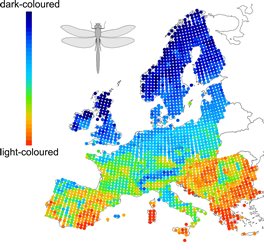Global warming favours light-coloured insects in Europe
Associations between biological traits of animals and climate are well documented by physiological and local-scale studies. However, whether an ecophysiological phenomenon can affect large-scale biogeographical patterns of insects is largely unknown. Insects absorb energy from the sun to become mobile, and their colouration varies depending on the prevailing climate where they live.

The map shows the mean colour lightness of dragonflies in Europe with assemblages dominated by light-coloured species in the south to assemblages dominated by dark-coloured species in the north. This distinct colour pattern across Europe was unknown until now. Credit: Zeuss et al. 2014.
In a new study by Carsten Rahbek and colleagues Dirk Zeuss and Stefan Brunzel from Philipps-University Marburg, using data of 473 European butterfly and dragonfly species, they show that dark-coloured insect species are favoured in cooler climates and light-coloured species in warmer climates. By comparing distribution maps of dragonflies from 1988 and 2006, they provide support for a mechanistic link between climate, functional traits and species that affects geographical distributions even at continental scales. The results constitute a foundation for better forecasting the effect of climate change on many insect groups.
